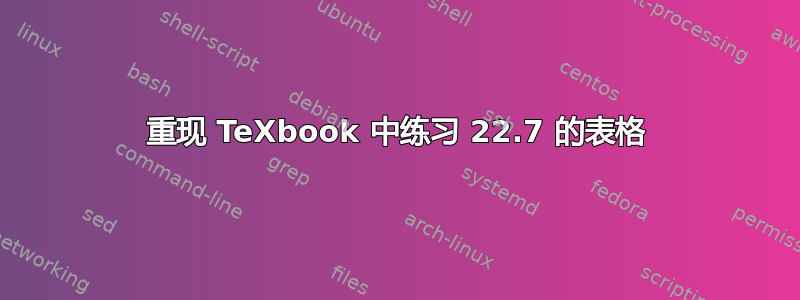
在 TeXbook 的练习 22.7 中,使用模板创建了一个特殊的表\halign:
\def\welshverb#1={{\bf#1} = }
\halign{\welshverb#\hfil\tabskip=1em plus 1em&
\welshverb#\hfil&\welshverb#\hfil\tabskip=0pt\cr
rydw i=I am& ydw i=am I& roeddwn i=I was\cr
rwyt ti=thou art& wyt ti=art thou& roeddet ti=thou wast\cr
mae e=he is& ydy e=is he& roedd e=he was\cr
mae hi=she is& ydy hi=is she& roedd hi=she was\cr}
答案1
你甚至可以做得更好,使用比 Knuth 更简洁的输入语法。
\documentclass{article}
\usepackage{collcell}
\ExplSyntaxOn
\NewDocumentCommand{\welshverb}{m}
{
\stephen_welshverb:w #1
}
\cs_new:Npn \stephen_welshverb:w #1 =
{
\textbf{#1}\unskip\ =\ \ignorespaces
}
\ExplSyntaxOff
\begin{document}
\begin{tabular}{@{} *{3}{>{\collectcell\welshverb}l<{\endcollectcell}} @{}}
rydw i = I am & ydw i = am I & roeddwn i = I was \\
rwyt ti = thou art & wyt ti = art thou & roeddet ti = thou wast \\
mae e = he is & ydy e = is he & roedd e = he was \\
mae hi = she is & ydy hi = is she & roedd hi = she was
\end{tabular}
\end{document}
答案2
这是一个解决方案,除了从 到的\welshverb微小更改外,它保留了 Knuth 的定义。\bf\bfseries
\documentclass{article} % or some other suitable document class
\usepackage{array}
\def\welshverb#1={{\bfseries #1} = }
\begin{document}
\begin{tabular}{ *{3}{>{\welshverb}l} }
rydw i=I am& ydw i=am I& roeddwn i=I was \\
rwyt ti=thou art& wyt ti=art thou& roeddet ti=thou wast \\
mae e=he is& ydy e=is he& roedd e=he was \\
mae hi=she is& ydy hi=is she& roedd hi=she was
\end{tabular}
\end{document}
答案3
如果您想使用某种高级语言来完成该任务,您可以使用该collcell包来获取整个单元格内容,并使用 l3 实现按等号进行拆分。
这样可以在输入的等号前后放置可选空格,而不会改变输出(使用 plainTeX 解决方案,您将获得双倍的空格)。
\documentclass{article} % or some other suitable document class
\usepackage{array}
\ExplSyntaxOn
\NewDocumentCommand\welshverbcell{m}
{
\tl_if_in:nnTF {#1} { = }
{
% implementation here assumes just one = is present at top level (else
% everything after the second equals sign is lost)
\seq_set_split:Nnn \l_tmpa_seq { = } {#1}
\exp_args:Nee \welshverbformat
{ \seq_item:Nn \l_tmpa_seq 1 }
{ \seq_item:Nn \l_tmpa_seq 2 }
}
{#1} % ignore cells not containing an equals sign
}
\ExplSyntaxOff
\NewDocumentCommand\welshverbformat { m m }
{%
\textbf{#1} = #2%
}
\usepackage{collcell}
\begin{document}
\begin{tabular}{ *{3}{>{\collectcell\welshverbcell}l<{\endcollectcell}} }
rydw i=I am& ydw i=am I& roeddwn i=I was \\
rwyt ti=thou art& wyt ti=art thou& roeddet ti=thou wast \\
mae e=he is& ydy e=is he& roedd e=he was \\
mae hi=she is& ydy hi=is she& roedd hi=she was
\end{tabular}
\end{document}





